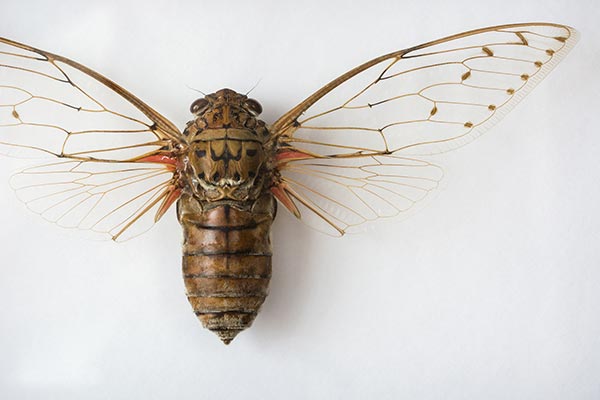
Researchers at West Virginia University studied the zombie-making fungus Massospora cicadina, which infects cicadas from the Magicicada genus.
Native to eastern North America, the periodical Magicicada spp. spend most of their lives as underground nymphs, emerging only as adults once they reach their 13th or 17th year, depending on the species.
“Flying salt shakers of death”
While the infected cicadas are underground, M. cicadina remains dormant in their bodies. It's when the insects finally emerge as adults, however, that the fungus strikes — that is, by causing their abdomens and genitals to fall off and replacing these parts with a spore mass. This mass or “plug” then begins dropping deadly spores, while the insect continues to walk and fly around like normal. This behavior has caused West Virginia University Ph.D. candidate Angie Macias to dub the infected cicadas as “flying salt shakers of death.”
It's not this process that turns the cicadas into zombies, however.
As the fungus bursts out of the cicadas, it releases psychoactive compounds into the cicadas' brains, causing the insects to go into a sexual frenzy. This causes each infected cicada to continually attempt to mate with others — with males even acting like females to attract other males to mate with them — all in an effort to spread the infection.
Interestingly enough, even as other parts of their bodies begin to turn moldy and rot off, the cicadas don't slow down. “Infected adults maintain or accelerate normal host activity during sporulation, enabling rapid and widespread dispersal prior to host death,” study author Matt Kasson, a forest pathologist at West Virginia University, said.
“Zombie-making” fungus produces psychoactive compounds similar to those in khat, magic mushrooms
While studying the zombie-making fungus, the research team discovered some interesting things about the chemicals they produced to take control over the cicadas. Among the various chemicals used by the fungus, the researchers found evidence of a plant-associated amphetamine and a psychoactive chemical found in magic mushrooms.
In a number of cicadas infected with M. cicadina, the researchers found signs of cathinone, a plant alkaloid similar to ephedrine. Usually derived from the herb ma-huang (Ephedra sinica), ephedrine is a stimulant that can improve metabolism and increase weight loss.
Cathinone has similar, albeit much stronger, effects to ephedrine. The scientists believe that the fungus uses this chemical to suppress its host cicada's appetite while also giving the insect the energy boost it needs to power through orgies.
Cathinone is more commonly found in khat, a plant whose leaves are often chewed in certain cultures to produce a high. The cathinone found by the study is the first example of it being produced in something other than a plant.
In addition, cicadas infected with another fungal pathogen, Massospora levispora, also had high levels of psilocybin, a psychedelic compound found in magic mushrooms.
Studying zombie-making fungi to find new medicines
While the study of the zombie cicadas and the killer fungus that infects them may seem like a macabre exercise, there is a reason behind it. The researchers believe that studying how the fungus works and what chemicals it produces could lead to the discovery of novel new medicines.
“We anticipate these discoveries will foster a renewed interest in early diverging fungi and their pharmacologically important secondary metabolites, which may serve as the next frontier for novel drug discovery,” said Kasson.
But while the quest to find medicines may be commendable, there already are natural sources for the ones that are known to come from zombie-making fungi. Despite legal impediments to obtaining them — both cathinone and psilocybin are Schedule 1 drugs — they've been consumed by people through their plant sources for centuries. For instance, psilocybin is present in magic mushrooms, which are much safer than other recreational drugs.
Sources include:
Please contact us for more information.























